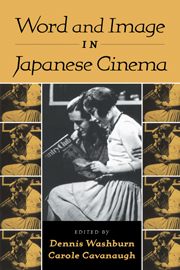Book contents
- Frontmatter
- Contents
- List of Illustrations
- Contributors
- Foreword: Outside Views of the Japanese Film
- Introduction
- PART ONE WORDING THE IMAGE/IMAGING THE WORD
- 1 The Word before the Image: Criticism, the Screenplay, and the Regulation of Meaning in Prewar Japanese Film Culture
- 2 The Cinematic Art of Higuchi Ichiyô's Takekurabe (Comparing Heights, 1895–1896)
- 3 Once More and Gosho's Romanticism in the Early Occupation Period
- 4 The Taunt of the Gods: Reflections on Woman In The Dunes
- 5 Adapting The Makioka Sisters
- 6 In the Show House of Modernity: Exhaustive Listing in Itami Jûzô's Tanpopo
- PART TWO REFLECTIONS OF IDENTITY
- PART THREE OUTSIDE THE FRAME OF CULTURE
- Selected Bibliography of Articles and Books in English
- Index
5 - Adapting The Makioka Sisters
Published online by Cambridge University Press: 01 March 2010
- Frontmatter
- Contents
- List of Illustrations
- Contributors
- Foreword: Outside Views of the Japanese Film
- Introduction
- PART ONE WORDING THE IMAGE/IMAGING THE WORD
- 1 The Word before the Image: Criticism, the Screenplay, and the Regulation of Meaning in Prewar Japanese Film Culture
- 2 The Cinematic Art of Higuchi Ichiyô's Takekurabe (Comparing Heights, 1895–1896)
- 3 Once More and Gosho's Romanticism in the Early Occupation Period
- 4 The Taunt of the Gods: Reflections on Woman In The Dunes
- 5 Adapting The Makioka Sisters
- 6 In the Show House of Modernity: Exhaustive Listing in Itami Jûzô's Tanpopo
- PART TWO REFLECTIONS OF IDENTITY
- PART THREE OUTSIDE THE FRAME OF CULTURE
- Selected Bibliography of Articles and Books in English
- Index
Summary
Ichikawa Kon claims he wanted to adapt Tanizaki Jun'ichirô's Makioka Sisters (Sasameyuki) in 1948, when the novel first appeared and he was still an assistant director. The dream faded, particularly when others adapted the book for the screen, first in 1950 and later in 1959, but was revived when a Toho producer asked him, in the early 1980s, to direct a new version of the literary classic. A large budget was assigned to the consequently lavish production, whose release was scheduled to coincide with Toho's fiftieth anniversary in 1983. Despite a budget that could have accommodated the necessary special effects, Ichikawa's version is stately and quiet and omits the most dramatic occurrence in the novel: the Kobe flood of 1938. Nevertheless, the film preserves the ethos of the novel, essentially an upper-middle-class “home drama,” and in spite of the inevitable condensation required to adapt a 500-page novel to film,1 the story, characters, and even minute events from the novel are clearly recognizable. There are, however, minor changes as well as obvious omissions that subtly rework the novel's ideology. Tanizaki's paean to a lost world of leisurely and refined, upper-middle-class culture becomes, in Ichikawa's hands, not only a tribute to an earlier style of filmmaking, but also an exercise in traditionalism, intended to affirm Japanese identity at a time when Japan was reemerging as a major commercial and industrial power.
Tanizaki's novel covers five years in the lives of the four Makioka sisters, daughters of an old, respected, and once-wealthy merchant family in Osaka, Japan's traditional center of bourgeois culture.
- Type
- Chapter
- Information
- Word and Image in Japanese Cinema , pp. 108 - 125Publisher: Cambridge University PressPrint publication year: 2000



